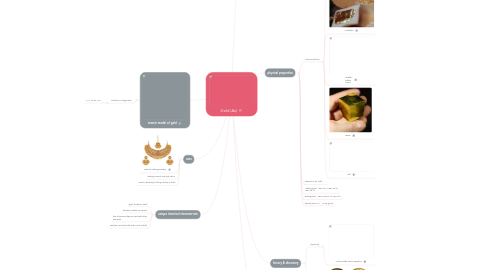Gold (Au)
por Jaimini Ram


1. atomic model of gold
1.1. electronic configuration
1.1.1. 2, 8, 18, 32, 18, 1
2. uses
2.1. used for making jewellery
2.2. making coins of very high value
2.3. used in dentistry for filling cavities in teeth
3. unique chemical characteristic
3.1. gold- transition metal
3.2. transition metals are unique
3.3. this is because they can bod with other elements
3.4. and also can bond with outer most 2 shells
4. introduction
4.1. Atomic number 79
4.1.1. number of protons = number of electrons = 79
4.2. Symbol Au comes from Latin: Aurum
5. physical properties
5.1. In its purest form
5.1.1. ductile
5.1.2. malleable
5.1.3. reddish- yellow colour
5.1.4. dense
5.1.5. soft
5.2. Phase (at STP) solid
5.3. Melting point 1337.33 K (1064.18 °C, 1947.52 °F)
5.4. Boiling point 3243 K (2970 °C, 5378 °F)
5.5. Density (near r.t.) 19.30 g/cm3
6. history & discovery
6.1. discovery
6.1.1. in the middle east in 6000bce
6.2. history
6.2.1. historically gold coinage was widely used as currency
6.2.2. when paper money was introduced
6.2.2.1. A reciept redeemable for a gold coin or bullion
7. alloy
7.1. tumbaga
7.1.1. tumbaga is the name for a non-specific alloy of gold and copper given by Spanish Conquistadors
7.1.2. uses
7.1.2.1. Tumbaga was widely used by the pre-Columban cultures of Central America to make religious objects.
